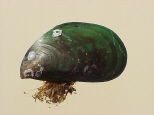Perna viridis
Green Mussel/Green-lipped Mussel
Class: Bivalvia
Order: Mytiloida
Family: Mytilidae

Photographer: Amy Benson, USGS
Source: http://nas.er.usgs.gov/queries/FactSheet.aspx?speciesID=110
Description
The green mussel is a large bivalve with a maximum length of 80 mm. The shell of Perna viridis is smooth with a distinct green coloration around the edge, which becomes increasingly brownish towards the point of growth. Young mussels are bright green and become darker with age. These mussels are very gregarious and are usually found in large clusters.
Ecological Threat: Green mussels are biofoulers, which means they clog up pipes necessary for certain operations. Perna viridis has impacted power plants in India several power plants in Florida by fouling the surface of intake condenser tunnels. They are also notorious for fouling navigation buoys in China. Other potential negative impacts include competition with the oyster fishery, displacement of native mussels, and carriers of diseases and parasites harmful to native species. In addition to parasites and diseases, the green-lipped mussels can accumulate toxic substances when they grow in polluted waters, which wen consumed can cause Paralytic Shellfish Poisoning.
Biology: Typical to other Mytilid mussels, Perna viridis attached to hard surfaces by means of byssal threads excreted from the body. Perna viridis is a filter-feeder, consuming mainly phytoplankton and organic detritus. Fertilization occurs in the water when male and female mussels excrete sperm and eggs that then combine to form a zygote. Spawning usually occurs in the early spring and late autumn but green mussel specimens found off of the coast of Thailand can spawn year-round. Larvae remain free-floating for 10-12 days before settling on the sediment below forming the juvenile stage. This stage lasts for about 2-3 months and they become sexually mature and an adult can live up to 3 years.
History: Possible ways of introduction include ballast water dumping from oceangoing vessels carrying planktonic larvae, ship hull fouling, and intentional release. Perna viridis has been established along the Atlantic coast and the Gulf Coast of Florida as early as 1999. Now the green mussel is found in the Gulf of Mexico from Freeport, Texas to Veracruz, Mexico.
U.S. Habitat: Perna viridis prefers partly enclosed brackish waters (estuaries) and can live in a wide range of salinity levels.
Distribution
Native Origin: Asia-Pacific and Indo-Pacific waters
U.S. Present: FL, GA, TX and potentially LA, MS and AL
Management
Eradication of these species in a water body is extremely difficult and unlikely. The green mussel is likely to spread until it reaches its lower temperature tolerance. In closed environments, such as power plants, mechanical or chemical control methods can be employed to reduce or eliminate this species where problems occur. To eliminate the source of many introductions, anti-fouling paints and ballast water management are being researched. Large and small boats coming from infested waters should be inspected before proceeding to non-infested waters. Texas Parks and Wildlife have this mussel on the Species of Concern list and reporting any sightings to any state or federal invasive species/wildlife entity is encouraged.
References
Rajagopal, S., V. P. Venugopalan, J. Azariah, K. V. K. Nair. 1995. Response of the green mussel Perna viridis (L.) to heat treatment in relation to power plant biofouling control. Biofouling, 8(4).
Woodward, Susan L., and Joyce Ann. Quinn. 2011. Asian Green Mussel. Encyclopedia of Invasive Species: From Africanized Honey Bees to Zebra Mussels. Santa Barbara, CA: Greenwood. 56-57. Print.
Internet References
http://www.galvbayinvasives.org/
http://www.reef.crc.org.au/discover/
 Texas Invasive Species Institute
Texas Invasive Species Institute